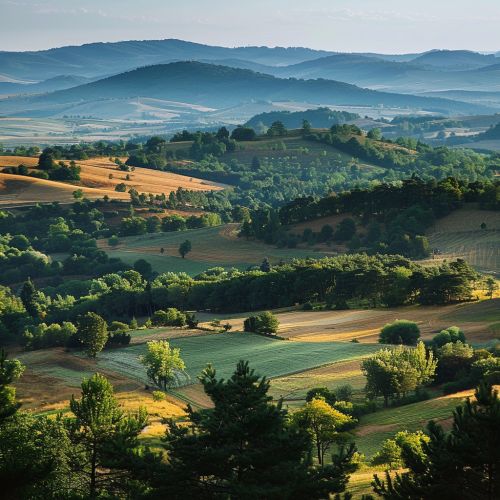Romania
Geography
Romania is located in southeastern Europe, bordering the Black Sea. It is positioned between Bulgaria and Ukraine, and also borders Hungary, Serbia, and Moldova. With a total area of 238,397 square kilometers, it is the twelfth largest country in Europe.


The country's terrain is distributed roughly equally among mountains, hills, and plains. The Carpathian Mountains dominate the center of Romania, with 14 of its mountain ranges reaching above 2,000 meters. The highest peak, Moldoveanu, stands at 2,544 meters.
The Danube River forms much of the southern boundary of the country, flowing into the Black Sea and forming the Danube Delta, the second largest and best preserved of Europe's deltas. The delta hosts over 300 species of birds and 45 freshwater fish species in its numerous lakes and marshes.
History
Romania's history has been shaped by its strategic location on the Black Sea and by its rich natural resources, particularly petroleum and metals. The territory's history can be traced back to the Paleolithic era, with the earliest human remains found in Peștera cu Oase dating approximately 40,000 years back.
The Dacians, an Indo-European people, were the earliest known inhabitants, and their kingdom reached its peak in the 1st century BC before being conquered by the Roman Empire. The Romans then merged with the Dacians, giving birth to the Romanian people and language.
In the Middle Ages, Romania was divided into several small principalities, including Wallachia, Moldavia, and Transylvania. The principalities were under the rule of the Ottoman Empire for several centuries, until they gradually gained autonomy and finally united under one rule in 1859, forming the modern state of Romania.
Romania gained full independence in the aftermath of the Russo-Turkish War in 1877-78. The country fought on the side of the Allies in World War I, and at the end of the war, Transylvania was united with Romania, significantly enlarging the country's territory.
During World War II, Romania initially aligned with the Axis powers but switched sides in 1944 as the war turned against Germany. After the war, Romania fell within the Soviet sphere of influence and became a socialist republic.
The fall of the Iron Curtain in 1989 led to the end of communist rule in Romania, and the country transitioned to a market economy. Romania joined NATO in 2004 and the European Union in 2007.
Politics
Romania is a semi-presidential republic where executive functions are shared between the president and the prime minister. The president is elected by popular vote and is the head of state. The prime minister, who is the head of government, is appointed by the president and needs to obtain a vote of confidence from Romania's parliament, the bicameral Parliament of Romania, which consists of the Senate (Senat) and the Chamber of Deputies (Camera Deputaților).
The judicial system is independent of the executive and the legislature, and is made up of a hierarchical system of courts culminating in the High Court of Cassation and Justice. Romania's legal system is a mix of civil law and constitutional justice, the latter based on the constitution, which is the supreme law of the land.
Romania is divided into 41 counties and the municipality of Bucharest. Each county is administered by a county council and a prefect.
Economy
Romania has a mixed economy, with a high-income level and a very high Human Development Index. It has been a member of the European Union since 2007, and its economy is largely dominated by services, which account for 66% of the GDP, followed by industry and agriculture.
Romania is rich in natural resources, including natural gas, petroleum, coal, and a variety of minerals. The country also has a significant manufacturing sector, with industries such as machine building, metallurgy, chemical production, and food processing playing a key role.
In recent years, Romania has also developed strong sectors in information technology and automotive, with companies like Dacia becoming significant players in the global market. The country's IT sector has been growing rapidly, with Bucharest and Cluj-Napoca becoming significant tech hubs in Eastern Europe.
Culture
Romanian culture is a unique blend of influences from Latin, Greek, Byzantine, and Ottoman cultures. The country's cultural heritage can be observed in a multitude of ways, from its architectural treasures, such as the monasteries of Moldavia and the wooden churches of Maramureș, to its rich folk traditions, music, dance, and cuisine.
Romanian literature has a rich tradition, with notable authors such as Mihai Eminescu, Ion Luca Caragiale, and Mircea Eliade gaining international recognition. In the field of visual arts, Romania has produced prominent artists like sculptor Constantin Brâncuși, one of the most influential figures of modernist sculpture.
Romania is also known for its contribution to cinema, with the Romanian New Wave cinema gaining international acclaim since the mid-2000s. Directors like Cristian Mungiu and Corneliu Porumboiu have won prestigious awards at the Cannes Film Festival and other major European film festivals.
